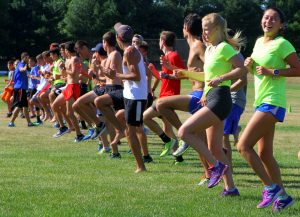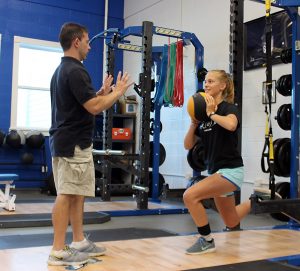June, July and August are a whirlwind for many performance coaches.
The absence of school and organized school athletics allow for plenty of time to train. For many coaches, this is the rare time of year they can apply their knowledge while gaining experience working with kids from morning until night. The days are long, but the experience, impact and financial reward is often much greater than any other time of the year.
Without a little planning however, the spoils of summer can quickly turn into the famine of fall.
Veteran youth S&C professionals have undoubtedly experienced the near burnout rate of summer only to find themselves hustling to find clients to make ends meet during the fall. Summer’s frenzy can distract coaches from creating a plan for the season right around the corner. This often forces coaches to put themselves in training situations during the fall that they don’t want to be in.
After experiencing this “feast and famine” cycle for many years, I realized that amongst the craziness of summer, I would need to start marketing for the fall. Believe me, this is the last thing I wanted to think about after a 12-hour day under the hot sun. However, once I learned to operate training more like a business and less like a hobby, both my year-round impact and income have received a significant bump.
Parents and coaches plan ahead, so to have the opportunity to work with kids and teams in the fall, they need to know what is available by the middle of summer. Once summer is over and kids go back to school, it’s too late. Imagine waiting until the day kids get out of school to tell a parent about a summer camp you are having. That parent would politely list the 30 other things they had already committed their kids to.
Below are some summer strategies to end the annual “feast and famine” cycle and begin creating opportunities for fall and beyond.
Construct a Coach/Program Database
Every youth S&C coach should not only be familiar with all of the seasonal and year-round sports in their area, they should have an active database with contact information for school and club coaches. This information can be obtained through websites and even from kids/parents. This provides an outline of possibilities for any time of year. It also provides a starting point for creating a relationship with coaches and organizations.
Create a Conversation with Coaches

For every child you work with, make sure to obtain the contact information for their coach/coaches. This not only goes into the large database, it provides a valuable opportunity to connect. Contact this coach and introduce yourself. Let them know you are working with their athlete and ask them for their perspective on what the child needs. Do not pitch a camp initially. As long as you are working with the child, provide occasional updates. Additionally, if there is a relevant article, blog or other pieces of valuable content you come across that impacts that coach’s sport, send it to them.
This way you are not only displaying that you care, but that coach will also begin to value your perspective. Enriching these relationships creates year-round opportunities.
Use the same approach with all the coaches in the database. Every day, make it a point to contact 5 of them. Even if you don’t work with one of their athletes, introduce yourself and your business. Share a link to a blog or other piece of valuable content. Let them know you’re sharing the “3 Exercises to Prevent ACL Injuries” blog with videos because you and your business are committed to “helping athletes perform for life.” No sales pitch, only a link to your webpage in the closing. If they reach out to thank you, it’s an opportunity to start a conversation and eventually work with them.
Understand Seasonal Cycles
All sports have an annual cycle of peak competition periods, off season, pre-season, etc. Most coaches will be the most interested in training during the 10-12 weeks leading up to their season. While summer is when fall athletes and coaches will probably be the most interested in training, fall is when winter sport athletes and coaches will be the most interested. Assuming you know the seasons, coaches, sports, etc. (your database), and you have created a dialogue with coaches, July is an ideal time to start offering pre-season training in September/October.
Mid to late July is also a time to start promoting general fall programs. Obviously, this means that the logistics and marketing materials are being created in early June. The marketing angle should address the winter sports and possibly even spring sports. Additionally, receiving this information during the summer allows parents to prioritize the idea. Early bird pricing, etc. can be a great way to get a commitment before school starts.
are being created in early June. The marketing angle should address the winter sports and possibly even spring sports. Additionally, receiving this information during the summer allows parents to prioritize the idea. Early bird pricing, etc. can be a great way to get a commitment before school starts.
The details for these fall offerings (days/times/prices) should be established prior to the beginning of summer camps. Kids and parents can sign up for “in-season” participation in training at a slightly discounted rate when they sign up for a summer package.
When it comes to in-season, there should always be an offering for teams to train during this time. Many teams are hesitant to commit to training during the season, so consider offering alternate programs that meet the needs of in-season athletes. For example, offer a weekly “recovery” session focusing on mobility, injury prevention or other recovery-based exercises. It may only be one day per week on a weekend, but it could be key to building a year-round relationship.
Consider All Sports
Many youth S&C coaches focus their marketing efforts on the most popular sports in their area. While the majority of children participate in these sports, other activities that are less mainstream can actually become tremendous markets. Dancers, figure skaters and other such athletes are often encouraged by their skill coaches to seek S&C coaches. Since many of these aren’t school sports, they aren’t subject to a seasonal ebb and flow. It’s important to include these organizations and coaches in your coach database.
I found that after school went back into session, young golfers and figure skaters were looking to train. I had formed relationships with local ice rinks, as well as a few golf pros by the process outlined above. My fall schedule would fill with these athletes and I was able to eventually consolidate individuals into large training groups.
Know the Pros
Working with professional athletes is highly seasonal. However, professional athletes are able to train during the daytime hours when kids are in school. During the fall, many minor league baseball players begin to return home. By the end of October, most major leaguers are ready to begin their off-season training, assuming they didn’t go deep into the playoffs.
If you don’t know any professional baseball players, get to know local agents. Understand who the baseball agents are in your area. Make sure to contact them and introduce yourself. Offer a tour of your facility or to meet them for coffee to let them know what you can do for their athletes. Study their players and stats so you can make specific references. If the agent feels you are vested, they are more likely to suggest training with you.
Use the Momentum of Summer
Mid-summer (Mid to late July) is when athletes, parents, and coaches are the most “bought in” to a program. They have been watching their youngsters grow under your care and the value of your program has never been higher. It’s essential to have offers for fall available during this time. A parent or coach who just witnessed their child do something better than they ever have, or catch their child doing a little “flex and smile” in the mirror, is going to be ready to commit. Again, the logistics and marketing materials need to be started in June.
Of course, as soon as fall training starts, it’s time to start creating opportunities for spring athletes to train in the winter!
Whether you own a gym/studio, or are employed by one, start thinking ahead to avoid the post-summer slump. Spend 30 minutes per day on the above steps to extend the success of summer far into the fall and beyond.
 Brett Klika is a youth performance expert and a regular contributor to the IYCA. He is the creator of the SPIDERfit Kids youth training program and has run successful youth fitness programs all over the country. Brett is an international speaker whose passion for youth fitness has helped thousands of people learn how to create exceptional training experiences for young athletes.
Brett Klika is a youth performance expert and a regular contributor to the IYCA. He is the creator of the SPIDERfit Kids youth training program and has run successful youth fitness programs all over the country. Brett is an international speaker whose passion for youth fitness has helped thousands of people learn how to create exceptional training experiences for young athletes.

